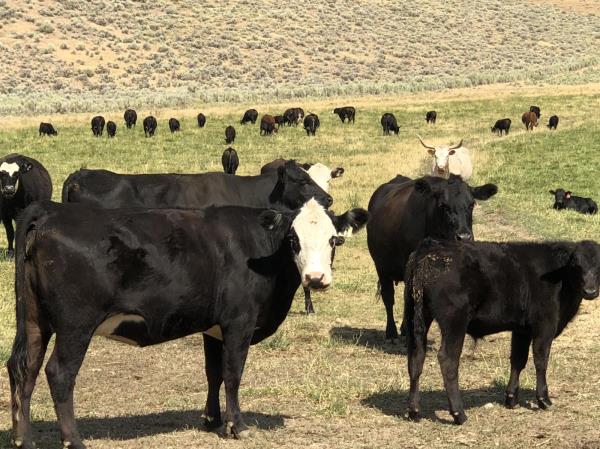A quick look at farming in Idaho's two congressional districts
 BOISE – The most recent Census of Agriculture data provides an interesting comparison to farming in Idaho’s two congressional districts.
BOISE – The most recent Census of Agriculture data provides an interesting comparison to farming in Idaho’s two congressional districts.
A lot of farming and ranching takes place in Idaho’s 1st congressional district, but not nearly as much as occurs in the state’s 2nd congressional district.
According to 2017 Census of Agriculture data that was released last April, farmers and ranchers in the 2nd district produce nearly four times the agricultural value of their colleagues in the 1st district.
Idaho has two congressional districts. The 1st includes all of northern Idaho and most of the southwestern part of the state. The 2nd district includes all of eastern Idaho and most of the city of Boise.
The census data shows that the market value of all farm products sold by producers in the 2nd district totaled $6 billion in 2017. In the 1st district, the total was $1.6 billion.
While a lot more farm revenue comes from the 2nd district, however, that doesn’t mean elected officials pay any less attention to agriculture in the 1st district.
Agriculture is the most important part of Idaho’s economy and is responsible directly and indirectly for one of every eight jobs in the state and 13 percent of Idaho’s total gross domestic product, according to a recent University of Idaho study.
Rep. Russ Fulcher, R-Idaho, who represents the 1st congressional district, told Idaho Farm Bureau Federation he fully recognizes that agriculture is the economic driver of the state.
“As the son of a dairy farmer, I understand the hard work and thin margins that Idaho’s farmers operate under,” he said. “Accordingly, I will continue to give the agriculture industry in the first district the priority it deserves and demands.”
During a Food Producers of Idaho meeting Jan. 22 – FPI includes 40 of the state’s main agricultural organizations – Fulcher emphasized his appreciation for Idaho’s agriculture industry.
“Don’t think for a minute that you don’t have a major impact on the state,” he said. “(Agriculture) is the economic engine that drives the state of Idaho … and I know that.”
Idaho Sugarbeet Growers Association Executive Director Brad Griff used to handle agriculture issues for former Rep. Raul Labrador, who represented the first district prior to Fulcher.
“Everyone on staff recognized that agriculture was the backbone of Idaho’s economy,” Griff said. “Even though the majority of the farm revenue is coming out of the 2nd district … we realized the profound impact that agriculture has on the 1st district as well. There is still plenty of agriculture in the first district.”
A lot of Idaho’s vast agricultural industry is closely linked and plenty of farm products produced in one congressional district pass through or are processed in the other.
Because so many of the agricultural commodities produced in Idaho cross back and forth between districts, Griff said, “I guarantee you if agriculture suffered in the 2nd district, you absolutely would feel the effect in the 1st district as well.”
The Census of Ag data shows that the total number of farms in each district is pretty even, with 12,742 in the 2nd district and 12,254 in the 1stdistrict. But the average size of farm in the 2nd district (595 acres) is much larger than it is in the 1st district (335 acres).
The 2nd district also includes most of the state’s dairy industry, which is the top farm commodity in Idaho in terms of total farm cash receipts.
In 2017, producers in the 2nd district had a combined total of $1.1 billion in net farm income, compared with $226 million in the 1st district.
The 2nd district also has 2.8 million acres of irrigated farmland compared with 580,000 acres in the 1st district.
In the 2nd district, 59 percent of total agricultural sales came from livestock products and 41 percent from crops. In the 1st district, 51 percent of sales came from livestock and 49 percent from crops.
There were 1,629 farms more than 1,000 acres in size in the 2nd district in 2017, according to the ag census, and 804 were that size in the 1stdistrict.
Idaho’s 2nd congressional district ranked very high nationally –there are 435 congressional districts in the nation – in several categories, including No. 2 for total vegetable acres harvested for sale, No. 3 for total potato, vegetable and melon acres and No. 13 in total sales.
Still can't find what you are looking for? Find by topic:
- Achievement Award (YF&R)
- Actions Alerts
- Advocacy
- Ag Ambassadors
- American Farm Bureau
- American Farm Bureau Policy Book
- Archive Photos
- Articles
- Board of Directors
- Calendar - State/District
- Calendar - County
- Capitol Reflections
- Collegiate Chapters
- Committee Application Form
- Commodities
- Convention Annual
- County Presidents & Board Information
- County Resource Page
- Delegate Form
- Discount Programs
- Discussion Meet
- Discussion Meet - High School
- Education Programs
- Events
- Excellence Award (YF&R)
- Expense Voucher
- Flickr
- Gem State Producer
- High School Discussion Meet
- High School Speech Contest
- Hope in Idaho Ag
- House of Delegates Credentials Form
- IFBF Board of Directors
- IFBF Policy Book
- IFBF Staff
- Insurance
- Legislative Action Program
- Legislative Issues
- Library
- MAC Trailer
- Magazines
- Map My Benefits
- Member Benefits
- Member Discount
- Membership Application
- Mission Statement
- Moving Agriculture to the Classroom
- Newsletter Sign up
- News Releases
- News Room
- Open Range Law
